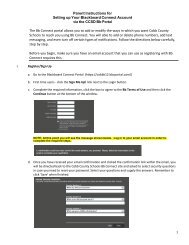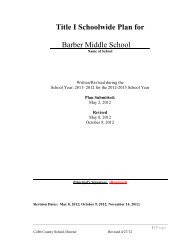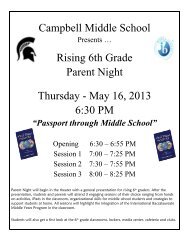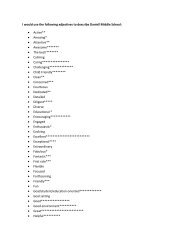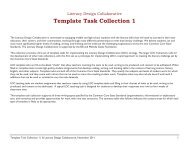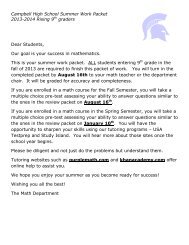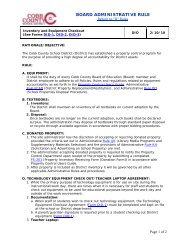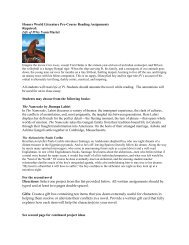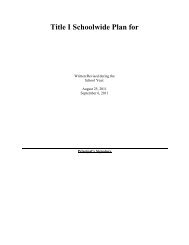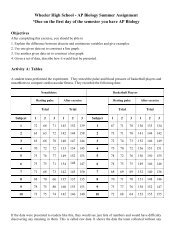Elementary Science Fair Planning Guide - Cobb County School ...
Elementary Science Fair Planning Guide - Cobb County School ...
Elementary Science Fair Planning Guide - Cobb County School ...
You also want an ePaper? Increase the reach of your titles
YUMPU automatically turns print PDFs into web optimized ePapers that Google loves.
Step 3: Testing your Hypothesis by doingan experimentNow we’ve come to the good part. The part that all scientists can’t wait to get their grubbylittle hands on… you guessed it… The EXPERIMENT!Designing an experiment is really cool because you get to use your imagination to come upwith a test for your problem, and most of all, you get to prove (or disprove) your Hypothesis.Now <strong>Science</strong> <strong>Fair</strong> Rules state that you cannot perform your experiment live, so you’ll haveto take plenty of pictures as you go through these seven very simple steps.First: Gather up your materials: What will you need to perform your experiment? The safest way todo this is get that adult you recruited to help you get the stuff you need. Oh, did we mention to take picturesor draw pictures of your materials. This will come in handy when you are making your board display.Second: Write a PROCEDURE. A procedure is a list of steps that you did to perform anexperiment. Why do you need to write it down? Well it’s like giving someone a recipe to your favoritedish. If they want to try it, they can follow your steps to test if its true. Scientists do this so that peoplewill believe that they did the experiment and also to let other people test what they found out. Did wemention to take pictures of yourself doing the steps?Third: Identify your variables. The variables are any factors that can change in an experiment.Remember that when you are testing your experiment you should only test one variable at a time inorder to get accurate results. In other words, if you want to test the affect that water has on plant growth,then all the plants you test should be in the same conditions, these are called controlled variables: sametype of dirt, same type of plant, same type of location, same amount of sunlight, etc. The only variableyou would change from plant to plant would be the amount of water it received. This is called the independentor manipulated variable. The independent variable is the factor you are testing. The resultsof the test that you do are called the dependent or responding variables. The responding variable iswhat happens as a result of your test. Knowing what your variables are is very important because if youdon’t know them you won’t be able to collect your data or read your results.Fourth: TEST, TEST, TEST. Remember that the judges expect your results to be consistent in orderto be a good experiment, in other words, when you cook from a recipe you expect the outcomes to be thesame if you followed the directions (or procedure) step by step. So that means you need to do the experimentmore than once in order to test it properly. We recommend five times or more. More is better!Don’t forget to take pictures of the science project being done and the results.Fifth: Collect your DATA. This means write down or record the results of the experiment every timeyou test it. Be sure You also need to organize it in a way that it is easy to read the results. Most scientistsuse tables, graphs and other organizers to show their results. Organizing makes the results easy to read,and much easier to recognize patterns that might be occurring in your results. (Besides, it impresses thejudges when you use them.) But don’t make a graph or table because we asked you to, use it to benefityour project and to help you make sense of the results. There is nothing worse than having graphs andtables that have nothing to do with answering the question of a science project.Page 8




